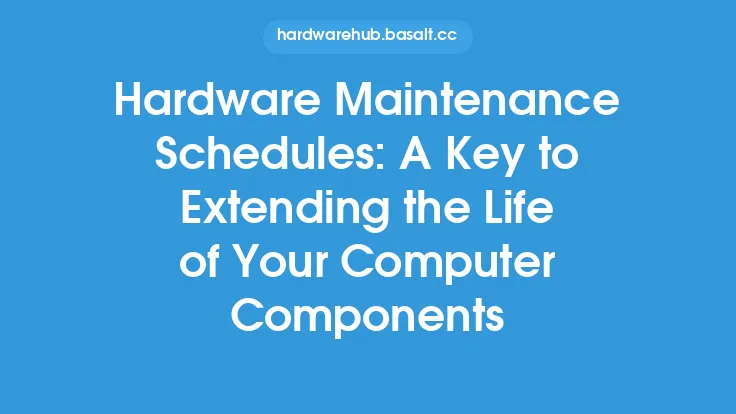When it comes to maintaining computer hardware, scheduling is crucial to ensure that all components are functioning properly and efficiently. Different types of hardware require different maintenance schedules, and understanding these requirements is essential to extend the life of your computer components. In this article, we will delve into the world of hardware maintenance and explore the various schedules required for different types of computer hardware.
Introduction to Hardware Maintenance Schedules
Hardware maintenance schedules are designed to prevent hardware failures, reduce downtime, and optimize computer performance. A well-planned maintenance schedule can help identify potential issues before they become major problems, allowing for prompt repairs or replacements. The frequency and type of maintenance required depend on the specific hardware component, its usage, and environmental factors. For instance, hardware components used in high-temperature environments or exposed to dust and moisture may require more frequent maintenance than those used in cleaner, cooler environments.
Scheduling Maintenance for CPU and Motherboard
The Central Processing Unit (CPU) and motherboard are critical components of a computer system. To maintain these components, it is essential to follow a regular cleaning schedule to remove dust and debris that can accumulate and cause overheating. The CPU and motherboard should be inspected every 6-12 months, and the thermal paste on the CPU should be replaced every 2-3 years or as recommended by the manufacturer. Additionally, the motherboard's capacitors should be checked for signs of wear and tear, such as swelling or leakage, and replaced if necessary.
Maintenance Schedules for Memory (RAM) and Graphics Cards
Memory (RAM) and graphics cards are also critical components that require regular maintenance. The RAM should be inspected every 6-12 months for signs of wear and tear, such as corrosion or physical damage. The graphics card, on the other hand, requires more frequent maintenance, especially if it is used for graphics-intensive applications such as gaming or video editing. The graphics card's cooling system should be cleaned every 3-6 months, and the drivers should be updated regularly to ensure optimal performance.
Hard Drive and Storage Maintenance
Hard drives and storage devices require regular maintenance to prevent data loss and ensure optimal performance. The hard drive should be defragmented every 1-3 months, depending on usage, and the disk space should be checked regularly to ensure that it is not filled to capacity. Additionally, the hard drive's SMART (Self-Monitoring, Analysis, and Reporting Technology) attributes should be checked regularly to identify potential issues before they become major problems. Solid-State Drives (SSDs), on the other hand, require less maintenance, but it is still essential to update the firmware regularly and ensure that the drive is not filled to capacity.
Power Supply and Cooling System Maintenance
The power supply and cooling system are critical components that require regular maintenance to ensure optimal performance and prevent overheating. The power supply should be inspected every 6-12 months for signs of wear and tear, such as corrosion or physical damage, and the cooling system should be cleaned every 3-6 months to remove dust and debris. The cooling system's fans should also be inspected regularly to ensure that they are functioning properly, and the thermal paste on the CPU and GPU should be replaced every 2-3 years or as recommended by the manufacturer.
Network and Peripheral Device Maintenance
Network and peripheral devices, such as routers, switches, and printers, require regular maintenance to ensure optimal performance and prevent connectivity issues. The firmware on these devices should be updated regularly, and the devices should be inspected every 6-12 months for signs of wear and tear. Additionally, the network cables and connectors should be inspected regularly to ensure that they are not damaged or corroded, and the devices should be restarted regularly to clear out any temporary issues.
Environmental Factors and Maintenance Schedules
Environmental factors, such as temperature, humidity, and dust, can significantly impact the maintenance schedule of computer hardware. Hardware components used in high-temperature environments or exposed to dust and moisture may require more frequent maintenance than those used in cleaner, cooler environments. For instance, hardware components used in industrial environments or outdoor settings may require more frequent cleaning and inspection than those used in office settings. It is essential to consider these environmental factors when creating a maintenance schedule for your computer hardware.
Tools and Software for Maintenance Scheduling
There are various tools and software available to help schedule and track maintenance for computer hardware. These tools can range from simple spreadsheets to complex software applications that can monitor hardware components in real-time. Some popular tools and software include hardware monitoring software, such as HWiNFO or GPU-Z, and maintenance scheduling software, such as Maintenance Connection or Fiix. These tools can help simplify the maintenance scheduling process and ensure that all hardware components are properly maintained.
Best Practices for Creating a Maintenance Schedule
When creating a maintenance schedule for your computer hardware, it is essential to follow best practices to ensure that all components are properly maintained. These best practices include identifying the critical components of your system, determining the maintenance requirements for each component, and scheduling maintenance tasks accordingly. It is also essential to document all maintenance activities, including the date, time, and details of the maintenance task, to ensure that all components are properly tracked and maintained. Additionally, it is essential to review and update the maintenance schedule regularly to ensure that it remains relevant and effective.
Conclusion
In conclusion, scheduling maintenance for different types of computer hardware is crucial to ensure that all components are functioning properly and efficiently. By understanding the maintenance requirements for each component and following a regular maintenance schedule, you can extend the life of your computer components, prevent hardware failures, and optimize computer performance. Whether you are a home user or an IT professional, creating a maintenance schedule for your computer hardware is essential to ensure that your system runs smoothly and efficiently. By following the guidelines outlined in this article, you can create a comprehensive maintenance schedule that meets the unique needs of your computer hardware.





